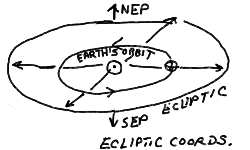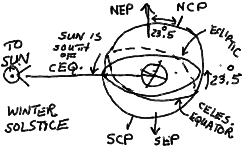 Temperatures --- | ---
Time & Tides
Temperatures --- | ---
Time & Tides

 Temperatures --- | ---
Time & Tides
Temperatures --- | ---
Time & Tides


Reading:
Chapter 2-3, 3-1 (ZG4)
 |
Key Question: | What determines which planets have atmospheres? |
|---|---|---|
 |
Key Principle: | Perfect Gases |
 |
Key Problem: | Which of the common gases would have escaped from Earth's atmosphere over the course of a few billion years? |
 |
Key Quote: | "A planet with no roof The leading edge of truth It's waiting up there Broken head spilling air what an atmosphere I really feel such a thrill" - Catherine Wheel, "Broken Head" |
I have not yet made up Web-notes for ideal gases, but you might want to check these out:
It is readily apparent that the Sun changes its RA and DEC throughout the year. It is high in the sky during the summer, and low in the sky during the winter. The night sky constellations change from Orion in the winter to Cygnus and the summer triangle in the summer. While the Earth revolves about the Sun, we see the Sun projected against a different backdrop of stars, or at least we would if we could see the stars in the daytime. The path of the Sun as it treks across the sky during the Earth's orbit is called the ecliptic (for reasons that will become clear in the next lectures). The ecliptic can also be thought of as the intersection of the plane of Earth's orbit with the celestial sphere. The ecliptic is not the same as the celestial equator because the Earth's rotation axis is tipped (see next section).
The rotation of the Earth is most easily defined against the repeating backdrop of stars. This, in many ways, gives us our preferred frame of reference. In one sidereal day, the Earth's rotation carries us around to see exactly the same stars at the same positions in the sky. The sidereal day is approximately 23h 56m 4s. Wait a minute (actually 4 minutes)! Why is this less than our 24 hour day? The day we are used to, the solar day is defined as the time it takes the Sun to be rotated around to appear on the meridian again - from noon to noon. This is longer than the sidereal day because in that day, the Earth has moved through approximately 1/365 of its orbit (the solar year is around 365.26 solar days long), placing the Sun an extra degree or so eastward on the ecliptic. To catch up to the Sun, we have to go just over an extra 1/365.26 of a day, or 4m. (If you were to lock the Earth facing the Sun and watch it revolve in its orbit from above, you would see it rotate one full revolution, or day, with respect to the fixed stars. It is this extra "day" that we need to make up during the year, 1/365 of it each actual day.)
We can define ecliptic coordinates like we have done for celestial coordinates and azimuth-elevation coordinates before. Perpendicular to the ecliptic plane are the North Ecliptic Pole (NEP) and the South Ecliptic Pole (SEP).

There are 12 constellations through which the ecliptic passes. These are the familiar "signs" of the Zodiac. Early astrology assigned special significance to those constellations through which the Sun, Moon, and planets pass on their celestial wanderings.
In temperate climates such as ours, we notice the cycle of the seasons quite readily. The warm summer is dictated by the Sun high in the sky during the long dog days, while the cold winter is feebly lit by the Sun low in the southern sky in those short days. This is a reflection of the fact that the ecliptic is inclined to the celestial equator by 23.5 degrees, which is equivalent to saying that the Earth's rotation axis is misaligned by 23.5 degrees with the "axis" of Earth's orbit around the Sun. If they were aligned, the Sun would move along the celestial equator and there would be no seasons (at least such as we know them).
It is the intersections of the ecliptic and the celestial equator that we use to define the reference points of our celestial coordinate system. On a sphere, two distinct great circles intersect at exactly two opposite points. In the spring, around the day of March 21, the Sun passes through the celestial equator on its way northward along the ecliptic. This time is known as the vernal equinox, when night and day have equal length, and is generally considered to mark the first day of spring (though it is seldom "springlike" so early!). This point of intersection on the celestial equator marks zero Right Ascension. On this day, the coordinates of the Sun are 0 hours RA and 0 degrees Dec. In the fall, the Sun crosses the equator going southward. This is the autumnal equinox, again with equal night and day. The sun on this day is at 12 hours RA and 0 degrees Dec.
Midway between the equinoxes, the Sun reaches its furthest north and south. The summer solstice occurs (in the northern hemisphere) around June 21, when the Sun is at 6 hours RA and 23.5 degrees Dec. Around December 21, the Sun is found at 18 hours RA and -23.5 degrees Dec at the winter solstice.

It should be stressed that it is the northward and southward migration of the Sun due to the inclination of the Earth's axis to the orbital axis that causes the seasonal climate that we experience on the Earth. It is not the slightly changing distance from the Sun that the Earth experiences during the year in its elliptical orbit. This change in distance is only about 3%, and in fact the closest approach, known as perihelion, occurs around January 3!
 Prev Lecture ---
Prev Lecture ---
 Next Lecture ---
Next Lecture ---
 Astr11 Index ---
Astr11 Index ---
 Astr11 Home
Astr11 Home
smyers@nrao.edu Steven T. Myers